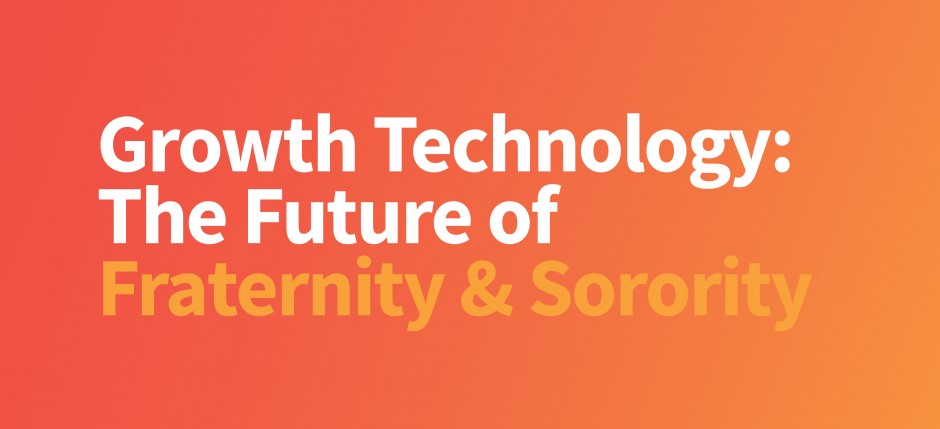Growth Technology: The Future of Fraternity & Sorority
by Josh Orendi
QUICK QUIZ: Answer any of the following questions:
- How many total people expressed interest in Greek Life last year?
- Who were they?
- What do we know about them?
- Do they represent the full community?
- Does anyone know how to contact these people?
- How many joined?
- Why did they join?
- How many stayed?
- Why did so many leave?
- Were the best people reached?
- Did the best people join?
- Did we unknowingly invite dangerous people?
- Were expectations of membership and PNM rights shared with every new member?
ANSWER: No one knows the answers to these questions (the list could easily go on and on). That’s the problem.
Fraternity/Sorority is a global brand with nearly 10 million initiated members, all from the most prestigious institutions of higher education … with real estate holdings, foundations, and annual revenues that I’ve been told exceed billions of dollars … yet we lack industry business systems to answer simple business questions (above).
Technology will change that. Soon.
CONSIDER THESE QUESTIONS for a few seconds each before reading the next one.
- If PNMs could design recruitment/intake the way they want it… how would it be different than what we do today?
- Do most undergrads rave about how much they like and appreciate the current process?
- If PNMs were fully educated/prepared consumers what might they demand and what might they no longer tolerate?
- If we had the data to know which PNMs were the safest, the most qualified, the most aligned… how much safer and higher performing might our chapters become?
- Today, the chapter’s support team – alumni volunteers, HQ, university staff – learns about PNMs for the first time AFTER they join. What if the support team had access to guide the chapter BEFORE/AS the chapter meets PNMs.
- If membership interest doubled or tripled next year, does the current model scale to support interest at that level?
- Is the current recruitment/intake process ready for the changing landscape of higher education?
- Do ALL students really feel welcome in the current process?
Fraternity and sorority is hundreds of years old, but we don’t have to act like a tired old brand that is scared of an uncertain future. Our target audience is wildly innovative 17-19 year old college students, and our front line representatives are wildly innovative 19-21 year old college students. Our young members want our help. They’re asking us to make the process better. We (those of us who are a part of the “fraternity/sorority industry”) are extremely well positioned to innovate if our old leaders (me included) are willing to embrace change.
We may not have a choice.
Our target audience of Gen Z pragmatists are running out of patience (check YouTube, Reddit, or ask them). Patience is not a quality Gen Z has in abundance. This is a generation that expects intuitive, efficient tech solutions that make their life simple.
CHANGE IS HERE:
- Gen Z won’t go to a car lot to shop for a car. They don’t care about showrooms and won’t tolerate being “sold” anything.
- Gen Z won’t go to the computer store. They are brand loyal or shop for tech exclusively online.
- Gen Z doesn’t bank at a bank. They don’t even carry cash.
- Gen Z won’t go to the grocery store. Kroger and McDonalds deliver.
- Gen Z doesn’t own a map.
- Gen Z doesn’t mail a letter.
- Gen Z doesn’t rent movies or buy CDs.
- Gen Z is actively challenging the ROI of higher education and the traditional campus/dorm/classroom model.
- Gen Z has already researched your organization and your members. They know how you rank before they arrive to “meet you.”
We’re fools to think Gen Z will tolerate “rush” or “intake” the old traditional way.
We have an opportunity in front of us to make fraternity and sorority better using technology tailored to the changing needs (demands) of our target Gen Z audience. We’d be better for it. We’d have answers to questions we should know. We could leverage technology to make fraternity safer and to better prepare PNMs to become retained, engaged, lifelong members! We could make the process more inclusive and welcoming to all students. So many benefits!
BUT THERE’S A PROBLEM
We’d have to come together and find agreement as an industry. That’s a big ask during a time when division seems more common than finding common ground. We’d also have to slay some sacred recruitment/intake cows that represent safety, power, tradition, and control. Those are not things people with authority are quick to give up.
So here we are. It’s almost 2020. The industry is de-centralized as if this were 1970. We’re trying to figure out why educating bad members isn’t working as though this were 1980. We’re still deep into rush t-shirts as if this were 1990. We have big plans to update our web presence as if this were 2000. Our Council PR chairs are trying to figure out Social Media marketing as if this were 2010. No one has their hands on the steering wheel of the global brand. Too many fraternity/sorority leaders are doing their very best to find answers to questions that were relevant decades ago. We can do better.
Many, many campuses still live in a world of bump groups, door stacks, skit rounds, rush event calendars, stale info tabling, billboard letters on campus, manual grade checks, printed PNM lists, Excel spreadsheets, and paper voting. ::Forehead Slap::
It’s still commonplace to force PNMs into a multi-day (or multi-week) process that requires everyone to be physically present, spend a lot of money they don’t have, dress up, and forces dozens of awkward conversations with people from dozens of chapters they aren’t saying they want to meet.
Chapter leaders are asking “how do we get them to pay attention to us, to show up, to stay, to come back, to want to join …” These questions are indicators that the process is broken and/or it isn’t the experience our Gen Z audience values.
To the defense of fraternity/sorority leaders everywhere, we’re trying to do what’s best for them. We’re doing our best with limited local resources and longtime volunteer teams, to adapt a process created 50+ years ago for today’s students. But, we should be asking if that process is the right process for the next 50 years?
Ok. Now breathe. Let’s be honest. This isn’t a do or die moment. This isn’t a problem that will kill fraternity/sorority. I’m not interested in dramatics. The fraternity/sorority industry is under attack and constantly defending itself. But, recruitment is not our biggest problem.
RIGHT?
You’ve heard wise fraternity/sorority advisors say that “all problems are recruitment problems,” and “we are who we recruit.” So, perhaps, this is exactly the big problem the industry should be solving — the one that we can control and that impacts all the other areas of fraternity/sorority.
If we don’t. Someone will.
Fraternity/Sorority is relevant and needed. And, that’s exactly why a couple 19 year old kids sitting in their dorm (or a chapter house) will soon experience our antiquated requirements and broken process and those naïve, innovative, Gen Z students will simply create an alternative option online. An alternative to the “old way to rush” that makes more sense to them. Their fellow students will see that option that looks cooler, faster, cheaper, and more relevant to them…. And, that’s when the fraternity/sorority industry will realize tradition does not trump innovation – not when the primary audience is 18-21 year old college students.
To be clear, students disrupting the industry with technology is NOT the problem. That happens frequently in the business world and it’s usually pretty cool when it happens. But it comes at a cost. Taxi drivers didn’t love Uber. Blockbuster wasn’t a fan of RedBox, and RedBox isn’t a fan of Netflix. Truck drivers aren’t as excited about self-driving vehicles as I am. Those big order screens at McDonald aren’t there to help the employees, they’re installed to replace them. Technology disruption shakes up industries that refuse to adapt and innovate.
There is an opportunity right now. Before a disruption.
Technology will change fraternity/sorority. It’s just a question of time and who will lead the change. So, what do you say those of us who care most deeply about fraternity/sorority make 2020 the year that technology modernizes recruitment/intake?

